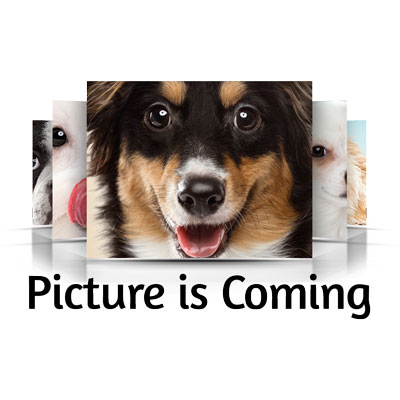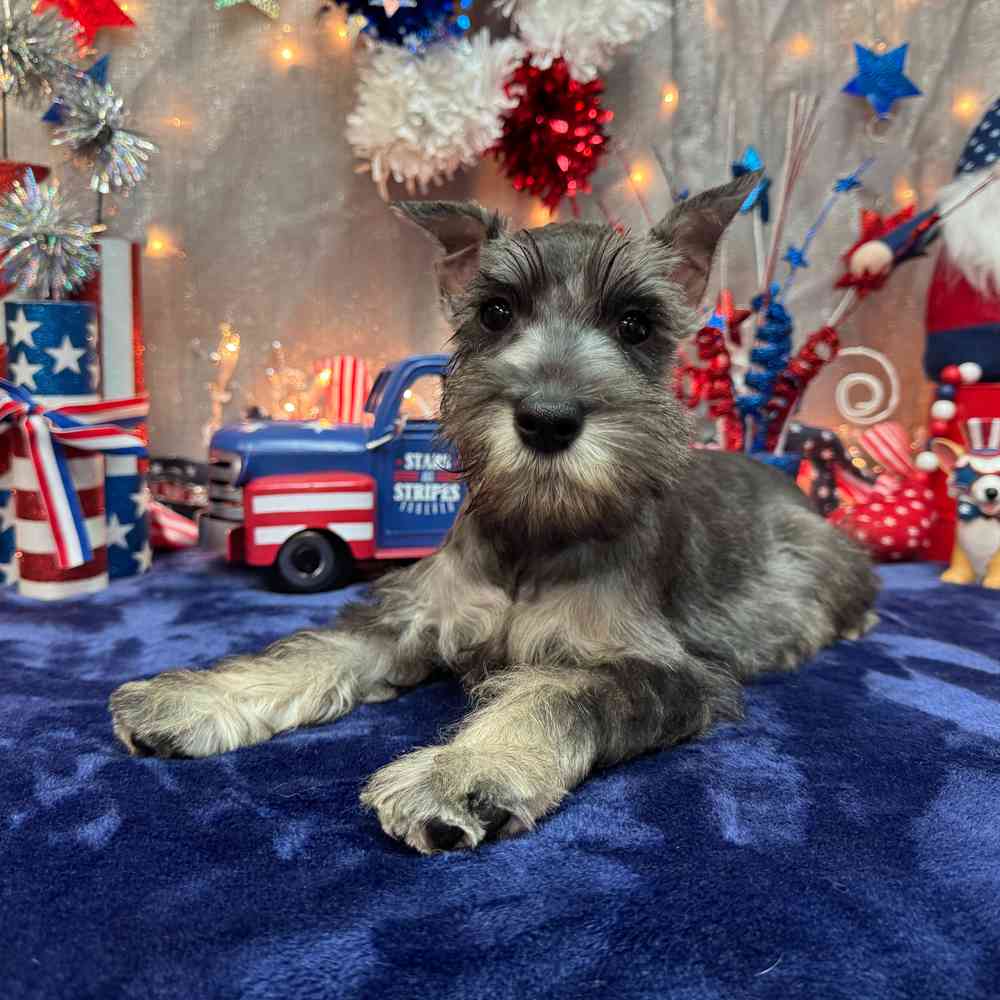
AKC Registrable
Sealyham Terrier
The Sealyham Terrier is brave and spirited, but not as spiky as smaller terriers. These sturdy, outgoing companions are recognized by their “fall,” the mass of hair covering the forehead. Sealy fans enjoy their dog’s sly sense of humor.
Available Pups
Puppy Knowledge
Breed Standard
General Appearance
The Sealyham should be the embodiment of power and determination, ever keen and alert, of extraordinary substance, yet free from clumsiness.
Size, Proportion, Substance
Height: At withers about 10½ inches. Weight: 23 to 24 pounds for dogs; bitches slightly less. It should be borne in mind that size is more important than weight.
Head
Long, broad and powerful, without coarseness. It should, however, be in perfect balance with the body, joining neck smoothly. Length of head roughly three-quarters height at withers, or about an inch longer than neck. Breadth between ears a little less than one-half length of head. Skull - Very slightly domed, with a shallow indentation running down between the brows, and joining the muzzle with a moderate stop. Cheeks - Smoothly formed and flat, without heavy jowls. Jaws - Powerful and square. Bite level or scissors. Overshot or undershot bad faults. Teeth - Sound, strong and white, with canines fitting closely together. Nose - Black, with large nostrils. White, cherry or butterfly bad faults. Eyes - Very dark, deeply set and fairly wide apart, of medium size, oval in shape with keen terrier expression. Light, large or protruding eye bad faults. Lack of eye rim pigmentation not a fault. Ears - Folded level with top of head, with forward edge close to cheek. Well rounded at tip, and of length to reach outer corner of eye. Thin, not t leathery, and of sufficient thickness to avoid creases. Prick, tulip, rose or hound ears bad faults.
Neck, Topline, Body
Neck: Length slightly less than two-thirds of height of dog at withers. Muscular without coarseness, with good reach, refinement at throat, and set firmly on shoulders. Shoulders: Well laid back and powerful, but not over-muscled. Sufficiently wide to permit freedom of action. Upright or straight shoulder placement highly undesirable. Body: Strong, short-coupled and substantial, so as to permit great flexibility. Brisket deep andwell let down between forelegs. Ribs well sprung. Back: Length from withers to set-on of tail should approximate height at withers, or l0½ inches. Topline level, neither roached nor swayed. Any deviations from these measurements undesirable.
Forequarters
Forelegs strong, with good bone; and as straight as is consistent with chest being well let down between them. Down on pasterns, knuckled over, bowed, and out at elbow, bad faults. Hind legs longer than forelegs and not so heavily boned. Feet - Large but compact, round with thick pads, strong nails. Toes well arched and pointing straight ahead. Forefeet larger, though not quite so long as hind feet. Thin, spread or flat feet bad faults.
Hindquarters
Very powerful, and protruding well behind the set-on of tail. Strong second thighs, stifles well bent, and hocks well let down. Cowhocks bad fault.
Tail
Docked and carried upright. Set on far enough forward so that spine does not slope down to it.
Coat
Weather-resisting, comprised of soft, dense undercoat and hard, wiry top coat. Silky or curly coat bad fault.
Color
All white, or with lemon, tan or badger markings on head and ears. Heavy body markings and excessive ticking should be discouraged.
Gait
Sound, strong, quick, free, true and level.
Overview
Group
Terrier
Temperament
Alert, Outgoing, Sense Of Humor
About
Standing less than 11 inches at the shoulder and weighing about 24 pounds, Sealys are not big enough to be considered medium-sized dogs, but they stand among the strongest and most substantial of what we think of as small dogs. A typical Sealy is well-muscled, built low to ground, and moves easily with long, determined strides. The weatherproof coat is predominantly white, and a long, broad head is furnished with lavish facial hair. Despite their rep as the bruiser among short-legged terriers, Sealys are cute, funny, affectionate, outgoing, and trainable, if a bit stubborn. Their alertness and a big-dog bark make Sealys excellent watchdogs. Blessed with an adaptable nature, Sealys are amenable to city dwelling or country life.
History
The name Sealyham Terrier honors the Sealy Ham estate on the Seal River, in southwestern Wales, where this sturdy and confident terrier was first bred. The father of the breed was an army captain named John Edwardes, who in the mid-1800s retired at age 40 and spent the rest of his life developing his dream dog. The Sealy’s primary purpose was to work in support of the captain’s Otterhound pack. Otters in those days were considered pests who depleted the fish population on sprawling estates like Sealy Ham. Edwardes bred his terrier to be strong and tough enough to dig razor-clawed otters out of their lairs. Edwardes left behind no written records of his breedings, and modern authorities disagree as to the exact pedigree of the captain’s original Sealys. Among the breed names bandied about in their theories are the Bull, Dandie Dinmont, and West Highland White terriers. Whatever the exact breed mix, the captain succeeded admirably, creating a fearless, hardworking hunter who was also a delightful companion by the fireside. The years between the world wars were the breed’s American heyday. Sealys won Westminster’s Best in Show award three times in this era, among them was the most famous show dog of the Prohibition era, a Sealy named Bootlegger. Their high profile was further boosted by A-list Hollywood owners like Humphrey Bogart, Gary Cooper, and Cary Grant. Sealy popularity with pet owners has waned since those heady days—puzzling, considering the breed’s many fine qualities. “They could be one of the best-kept secrets in dogs,” says one Sealy lover. The breed today is a bit larger and more affable than the feisty terriers first bred by Captain Edwardes. Their friendliness is put to good use as therapy workers in nursing homes and children’s hospitals.
Standard
Long, broad and powerful, without coarseness. It should, however, be in perfect balance with the body, joining neck smoothly. Length of head roughly three-quarters height at withers, or about an inch longer than neck. Breadth between ears a little less than one-half length of head. stop. Cheeks – Smoothly formed and flat, without heavy jowls. Jaws – Powerful and square. Nose – Black, with large nostrils. White, cherry or butterfly bad faults.
Nutrition
The Sealyham Terrier should do well on a high-quality dog food, whether commercially manufactured or home-prepared with your veterinarian’s supervision and approval. Any diet should be appropriate to the dog’s age (puppy, adult, or senior). For a Sealy who competes in dog shows, avoid food containing extra dye, as the dye tends to stain beards and may also color the urine, which can leave hair yellowish. Some dogs are prone to getting overweight, so watch your dog’s calorie consumption and weight level. Treats can be an important aid in training, but giving too many can cause obesity. Learn about which human foods are safe for dogs, and which are not. Check with your vet if you have any concerns about your dog’s weight or diet. Clean, fresh water should be available at all times.
Grooming
The breed’s weather-resistant, double “jacket” and profuse leg and body furnishings must be combed and brushed every two or three days, as Sealy coats tend to mat easily. The coat does not shed but must be hand-stripped or clipped on a regular basis. Pet Sealyhams can be kept trimmed short with minimal furnishings, which makes their care easier. Bathing every three to four weeks is a good idea. For Sealyhams in show coat, washing at least the furnishings frequently is a must. The nails should be trimmed regularly, and the eyes and ears should be checked during grooming sessions.
Exercise
Sealys love to run in a safely enclosed area and enjoy plenty of exercise. They can overheat in hot, humid weather, so exercise is best in the early morning and in the evening. Grass stains are common, and it may be necessary to wash furnishings and condition often. Encourage Sealys to exercise so they get moderately tired, but not exhausted, and they will be calmer in the house. Sealys can be very active, and exercise helps them be better house pets.
Training
As with most terriers, Sealys require a firm but not harsh training technique. The Sealy puppy should be socialized early, being gently exposed to a wide range of dogs, people, and places, and this will help to discourage any dog aggression later on. Sealys can be food guarders, and this must be corrected right away. Don’t allow the dog to get away with it, ever.
Health
Allergies are fairly common in the breed but are seldom of a really serious nature. There are several genetic eye diseases that potential sires and dams should be tested for before breeding. The American Sealyham Terrier Club provides detailed information on breed health. Non-genetic eye conditions such as tearing and infections can occur because of the breed’s long eyebrows. If the dog is a pet, a shorter eyebrow fall is a good idea. Ear infections can occur due to the weight and position of the ears, but keeping the ears clean is usually all that is required for prevention and maintenance.

